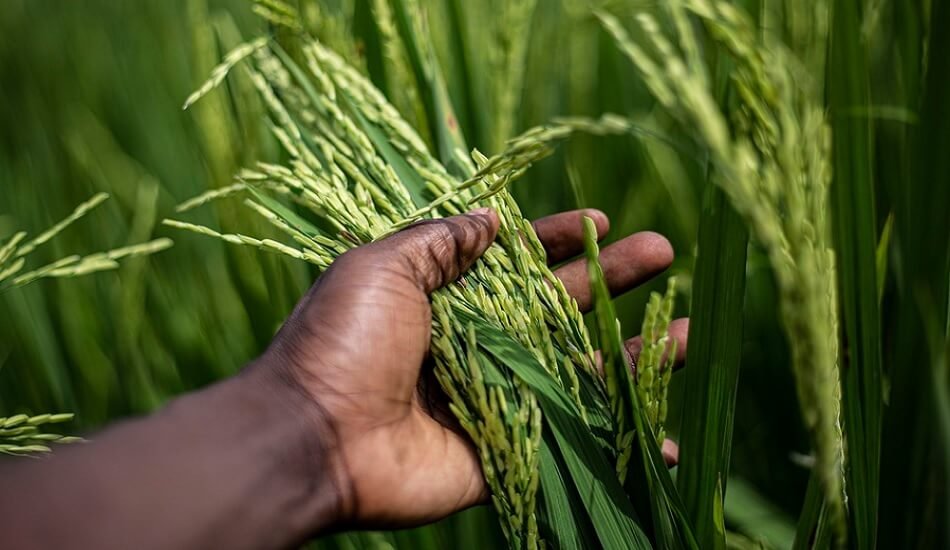Buddha’s gift to people, fragrant and nutritious Kalanamak rice, gains a new name.
Kalanamak, a traditional type of rice with a black husk and a rich aroma that is thought to have been a gift from Lord Buddha to the people of Sravasti following his enlightenment, is about to gain a new look and name. The traditional type, grown in 11 districts of northeastern Uttar Pradesh and Nepal, is susceptible to lodging, which accounts for its low yield.
Lodging is a condition in which the plant’s top grows heavy due to grain production, the stem weakens, and the plant falls to the ground. To address the issue, the Indian Agriculture Research Institute (IARI) created two dwarf varieties of Kalanamak rice. Pusa Narendra Kalanamak 1638 and Pusa Narendra Kalanamak 1652 are their names.
Also Read | New product to combat ‘yellow stem borer’ in rice will be launched: Corteva
According to the IARI, the new name has nothing to do with Prime Minister Narendra Modi and is in acknowledgment of the institute’s collaboration with the Acharya Narendra Dev University of Agriculture and Technology in Ayodhya to evaluate the two types. The yield of the new types is double that of the traditional variety, and the IARI and the Uttar Pradesh Council of Agriculture are collaborating to get the seeds to farmers as soon as possible.
The geographical indication (GI) tag system protects traditional Kalanamak rice. According to the GI application, Lord Budhha gave Kalanamak paddy to the people of Sravasti so that they would remember him by its smell.
Plant height problem
The original variety of Kalanamak paddy is tall and prone to lodging, which has a negative impact on grain filling and quality. As a result, the yield dropped dramatically, as did the market for rice. The yield of traditional Kalanamak paddy is only two to 2.5 tonnes per hectare.
According to IARI Director A.K. Singh, their goal was to introduce dwarfism into the variety and strengthen the plant to prevent lodging. ‘The plan was to mix the high-yielding variety with the quality of traditional Kalanamak.’ It has short grains. We started the breeding program by importing dwarfing genes from the rice variety Bindli Mutant 68, as well as the gene of Pusa Basmati 1176 as a parent to cross with Kalanamak, and the progenies were then back-crossed with Kalanamak to restore its quality. ‘This is a new mutation,’ he explained.
The procedure began in 2007, with the first cross with dwarf types. The IARI has performed detailed evaluations at ten Krishi Vigyan Kendras (KVK) located in GI districts during the previous three years. ‘It was distributed to farmers during the Kharif season.’ The new breed has a stronger scent and superior nutritional characteristics. ‘In comparison to traditional Kalanamak, productivity has increased to 4.5 to five tonnes per hectare,’ Dr. Singh stated.
Tilak Ram Pandey, a Sidhharth Nagar farmer, said his family has been producing traditional Kalanamak paddy for generations. ‘We regard this rice to be Lord Buddha’s prasad,’ Mr. Pandey explained. He conducted the new variety testing on eight acres of his land. ‘The old variety has a plant length of 140 centimetres, while the new variety has a plant length of 95-100 centimetres.’ On November 20, I will begin harvesting. It will produce a good harvest. The paddy was attacked by larvae, although it was far less than last year,’ he remarked.
Positive outcomes
According to Mr. Pandey, 75% of farmers in the area used to plant Kalanamak, but the demand for the type has recently dwindled. ‘The government has now provided encouragement. I participated in this experiment last year as well. I handed the rice to the experts and government officials who had been to my house. The flavor is excellent. ‘However, old-timers think the flavor will not match the classic version,’ he continued.
According to its Director, Professor S.N. Singh, the KVK in Basti has looked at the trials conducted by several farmers and the results are extremely good. ‘The yield is excellent, particularly on low-lying terrain.’ Production has increased thrice as compared to the traditional variety. Sowing is typically completed in July. Where sowing was done in August, the reaction was positive. We have distributed seeds to around 150 farmers in Basti. Kalanamak is grown on around 9,000 hectares in Basti,’ he noted.
Kalanamak is grown on around one lakh hectares in Uttar Pradesh.
Prof. Singh stated that the KVKs will give seeds for large-scale cultivation during the following agricultural season. ‘Farmers are overjoyed with this seed. We’ve been testing it for three years, and this season we distributed it to farmers as part of the trial. One issue was an outbreak of the bacterial illness blight. ‘We’ve also addressed it by inducing blight-tolerant genes,’ he said.
Also Read | Govt will sell wheat in open market to keep prices under control
B.N. Singh, a well-known rice breeder and former Director of Research at the Birsa Agriculture University in Ranchi, has been assisting the IARI in the development of new kinds. ‘We’ve been experimenting with this variety since 2015.’ The yield and cooking quality are both excellent. In general, this type is disease resistant. ‘Lodging has been ruled out,’ he said, adding that Kalanamak has a higher zinc and iron content than other rice varieties.
‘We sent the samples to the National Institute of Nutrition in Hyderabad to determine the nutritional components and the glycemic index. Diabetic patients can utilize this type if the glycemic index is low,’ Dr. Singh explained.


















Add Comment